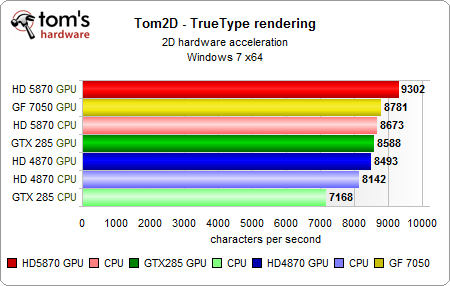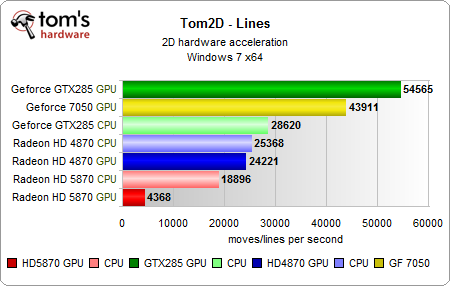2D, Acceleration, And Windows: Aren't All Graphics Cards Equal?
Tom2D Benchmark: Radeon HD 5870 Vs. GeForce GTX 285 In Windows 7
With the help of this new benchmark, we hope to better understand the root causes for the 2D bottlenecks we’ve so recently discovered for the Radeon HD 5870, 5850, and 5750 cards we have at our disposal. To begin with, we proved to ourselves that 2D acceleration of GDI functions in Windows 7 definitely doesn’t work for any of these Radeon HD 5000-series models, rather than simply slowing down dramatically. Is it a driver or a hardware problem? Nvidia doesn’t come through this testing blemish-free, either: even for its cards, not all possible functions are truly accelerated.
| Test System | |
|---|---|
| Processor | Intel Core 2 Quad Q6600, 2.4 GHz @ 3.2 GHz, G0 Stepping, 8MB L2 Cache, LGA 775 |
| RAM | 4GB DDR2-1066 CL5 |
| Motherboard | A-Data Vitesta Extreme |
| Operating System | Windows 7 Ultimate x64 |
| Graphics Cards | Radeon HD 5870, GeForce GTX 285 |
| Graphics Drivers | Catalyst 9.12, GeForce 195.62 |
| Graphics card | Clock Rate With Aero/DWM Enabled | Clock Rate With No Acceleration |
|---|---|---|
| ATI Radeon HD 5870 | 850 MHz | 157 MHz |
| Nvidia GeForce GTX 285 | 648 MHz | 300 MHz |
In order to establish a better baseline for the purposes of comparing 2D acceleration enabled/disabled, we also ran all of our tests on an older nForce 610i chipset with integrated GeForce 7050 graphics (lacking an on-board frame buffer). We installed the same CPU and 4GB RAM, and used the same 64-bit Windows 7 operating system. We also substituted the predecessor to the Radeon HD5870, ATI's Radeon HD 4870, in our other test platforms as well.
Test 1: Rendering TrueType and OpenType
All candidates fall into the same narrow range for this test.
We would like to hear what Nvidia has to say about why its on-board graphics processor renders 2D graphics faster than a GeForce GTX 285, even if the difference is fairly modest.
Using the Radeon HD 4870 as a baseline control placed it in the bottom third of the pack, without showing any real weaknesses of which to speak.
Test 2: Drawing Lines
Get Tom's Hardware's best news and in-depth reviews, straight to your inbox.
Surprisingly, the Radeon HD 5870 is simply incapable of rendering hardware-accelerated lines with any reasonable performance.
Whereas both of our test subject deliver acceptable and reasonably-close results with 2D acceleration turned off, leaving the job to the CPU, a substantial gap between the two cards opens up once we enable Aero. The GeForce GTX 285 runs as much as 11 times faster than ATI's Radeon HD 5870. Worse yet, an on-board graphics processor from a two year-old $50 motherboard bests this $400 graphics card by an order of magnitude.
Furthermore, our readings for the Radeon HD 4870 show little difference between Aero-enabled and basic (non-accelerated) Windows 7 graphics performance, suggesting no acceleration for drawing lines in Windows 7. This card is measurably slower than a GeForce GTX 285 and the on-board graphics solution, but is able to best the Radeon HD 5870 with acceleration turned on and off.
Current page: Tom2D Benchmark: Radeon HD 5870 Vs. GeForce GTX 285 In Windows 7
Prev Page Windows 7: Radeon HD 5000-Series Cards Lack 2D Acceleration Next Page Tom2D Benchmark Results, ContinuedTom's Hardware is the leading destination for hardcore computer enthusiasts. We cover everything from processors to 3D printers, single-board computers, SSDs and high-end gaming rigs, empowering readers to make the most of the tech they love, keep up on the latest developments and buy the right gear. Our staff has more than 100 years of combined experience covering news, solving tech problems and reviewing components and systems.
-
pcxt21 Very nice work! Until that little update I was ready to put my old Matrox Millennium (1996/1997 I think) 2d accelerator back into my gaming rig...Reply -
For those who still remember Matrox...shouldn't that be included in the test as well? Ancient history shows that it was the best card to be paired with VooDoo when first released...:PReply
-
one-shot LOL. The clip of Steve Ballmer looks like an ad from the late Billy Mays. To think he's the CEO of Microsoft after watching that clip makes me laugh. I'm going to watch it again.Reply -
chookman I actually went to put a Professional Matrox card (G550 PCI-e) in my Windows 7 machinde for a few more displays... alas it seems most of the range doesnt have Windows 7 drivers yet :(Reply -
Belardo The sad thing is, as shown was that Windows 1.0~3.0 were never an operating system, ever. 1.0~2.x we're never really used by anyone, yet Amigas and Macs had full GUI functionality since 85/84... Windows3 was at least usable, but still a single-tasking POS, and yet MS-DOS was able to dominate the computer industry... not because of talent, but because of luck, good moves by Gates & Ballmer and the stupidity of IBM. It kind of worked out anyway thou.Reply
Think about it, it wasn't until the tail-end of 1995, with the release of Windows95, did MS produce an actual GUI OS for the general public, 10 whole years after Apple's Mac and the Amiga by chicken lips. Atari only copied much of the hardware abilities of Amiga with a variant of a MS-DOS clone.
Only business bought PC-Clones in the 80s~90s, paying around $1500~4000 per desktop. Since IBM didn't make the OS and the hardware was generic, it was super easy for clones to exists. Home users bought Amigas and Macs and laughed as DOS users... but in the end, they lost to the clones.
At one time in 1990, the Computer Shopper Mag was about 500 pages (phone book) with at least 500 Clone companies advertising.
Windows is still the Copy-Cat OS. Its still an ugly beast under the hood. At least Windows7 runs good and looks nice.
-
Raid3r Indeed, way to take one for the team..I am one of those 2d workers and greatly appreciate the foot that was used to affirm the position of 2d recognition on these "new" cards. I can't say it enough.Reply -
micky_lund woot for toms...Reply
catch some more massive companies out, and make them fix up their drivers -
Belardo I just finished reading this entire article. A good one too guys.Reply
While I had my rant about old MS days, I did work in the PC field starting with 3.1. We'd benchmark various video cards with programs that would test lines, boxes, etc. This WAS important for some games like DOOM and Quake which were not "true" 3D cards we have today.
For every new type of PC build or a clients computer, I would save these generic overall system benchmarks. And I *have* notice different 2D performance abilities of computers and the various cards. All super fast compared to the 90s, but I've seen a GF card perform worse than an older ATI, but also an older ATI work a bit better than a newer one. These are all WinXP and don't have anything to do with the problems of Win7 and/or DX11... Part2 isn't out yet... but I would be curious to see if the problems in Win7 happens in Vista with DX11 installed hmmm.
ATI has been putting all their work into 3D gaming performance, its good to see that they have put a team to fix their 2D issues. There is a good chance that this is a DX11 issue they were not aware of. Since Nvidia doesn't have any DX11 parts (but a DX10.5) - this "bug" doesn't yet show... but I'm speculating of course. :)
With the eye-candy of Win7, the 2D performance *IS* important for those doing work, watching videos, etc. No good excuse to miss this, and hopefully ATI will have it resolved in 1-2 months.
PS: Your memory usage chart of vista vs Win7 shows exactly WHY Vist . That is why Windows7 runs pretty good on a 1GB computer, but Vista still needs at least 3GB for a bottom-end PC. My notebook has Win7rc with 1GB, runs fine.
Hey, will your results sometime include intel graphics? After this bug-issue is resolves, include overall-2D scores with your graphics Charts. :)


